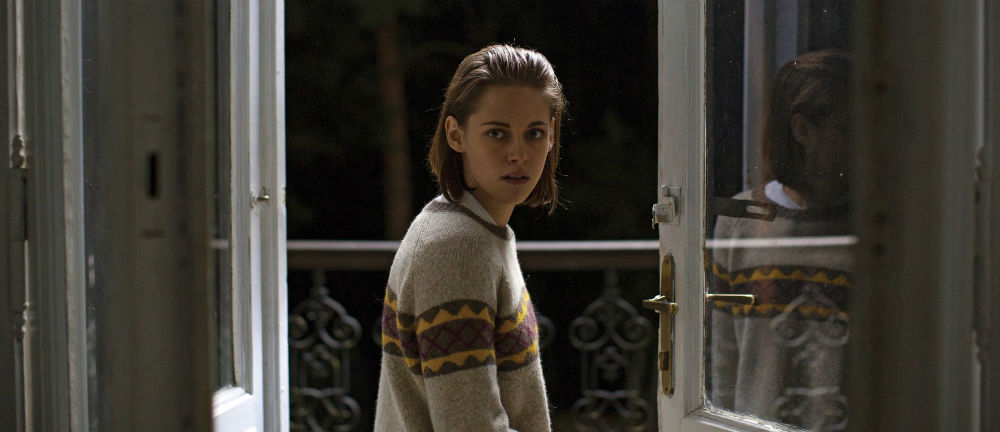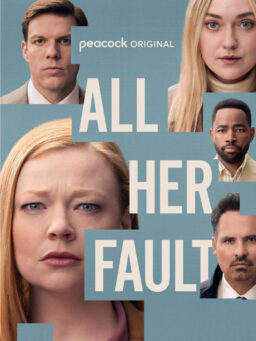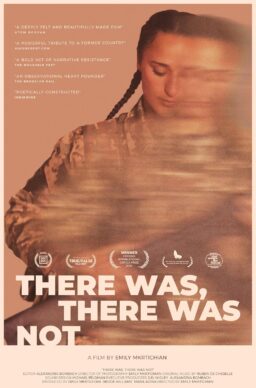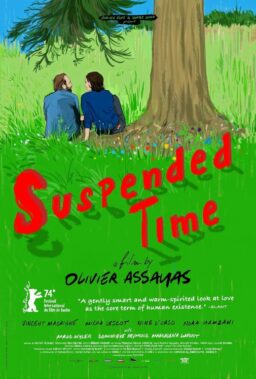We are pleased to feature an excerpt from the June 2017 edition of the online magazine Bright Wall/Dark Room, which is focused on the concept of The Hero’s Journey on film. Along with this essay by Kelsey Ford about “Personal Shopper” and “Raw,” the issue also features essays on “Superman” (1978), “Logan,” “Labyrinth,” “The Fisher King,” “Silence of the Lambs” and “Hannibal,” ‘The Wizard of Oz” and more
You can read previous excerpts from the magazine by clicking here. To subscribe to Bright Wall/Dark Room, or purchase a copy of their current issue, click here.
Even though you won’t believe me
my story is beautiful
And the serpent that sang it
Sang it from out of the well.
– Leonora Carrington
1.
Medusa wasn’t always a monster.
Before she became cursed with a halo of snakes and a gaze that could turn strangers to stone, Medusa was beautiful. Poseidon wanted her, but she didn’t return his affections; he cursed her. Medusa’s luscious blonde hair became angry snakes; her roseate cheeks became a sickly green; her gentle eyes became furious and blood-shot.
Her desires didn’t match the desires expected of her. She had a body a man could not claim.
She became a monster.
2.
Female monsters in movies are historically villains. They’re the thing to be defeated, the final feat on a quest. But recently, we’ve seen films that center the story around this monster. They are no longer the hero’s obstacle; they are their own obstacle, trying to understand the danger implicit in their existence. Under the Skin’s alien tries to contend with the boundaries of her new skin. The violent, selfish sister in Crimson Peak is ready and willing to fight anything that comes between her and the only love and comfort she’s known, no matter how twisted that love may be.
Two recent films, Raw and Personal Shopper, tease these elements out. In each, by the end of the film, you feel you know the character’s fears, their monstrous wants and needs, and the ways they fight the snowballing desire within.
In a speech Margaret Atwood gave in 1994, she said of female bad characters that they can “act as keys to doors we need to open, and as mirrors in which we can see more than just a pretty face.” She goes on: “if you’re a woman, the bad female character is your shadow.” They explore their subterranean depths, and you do along with them.
Telling their story is like seeing the dark side of the moon.
3.
Justine (Garance Miller) is a vegetarian and about to begin her first year at veterinary school. She’s petite with broad, cowering eyes, a prominent collarbone. Her actions, angular and careful, accentuate her bones, her sinew, her skeleton. Raw, the 2016 French film from Julia Ducournau, watches as Justine tries to hide from the incessant appetite unfurling inside her.
Her first night at the school, she’s woken by her disoriented roommate, Adrien (Rabah Nait Oufella). He’s carrying a ski pole. Loud noises filter through the hallway until fervent, masked men break in, yelling in their faces, tossing mattresses out windows. The intruders herd Justine and Adrien out into the hallway, into a line of other cowering first years. It becomes clear, quickly, that this is Rush Week. The second years take their hazing seriously. If anyone backs down, they’re expelled, their faces scratched from the class photo.
With her new classmates, Justine crawls along concrete, slowly, one of a herd, toward a rager hidden at the end of a long corridor. The next day, blood is dumped over the first years, just before the class photo. After, the first years are lined up. When Justine and Adrien reach the front, they realize that they’ve been waiting to ingest a raw rabbit liver. Justine protests. She’s a vegetarian. She pulls her sister, Alexia (Ella Rumpf), over to vouch for her. Alexia, however, is a second year. She ate the liver the year before and doesn’t want her sister to chicken out.
Justine, faced with expulsion or meat, chooses the meat. She nearly retches, but the liver doesn’t come up and, like that, the maw of Justine’s desire has been pushed open.
She does her best to ignore it, but she can’t. She tries to steal a beef patty. Adrien catches her and takes her to a truck stop to eat shawarma. Later, back in their dorm, when Adrien isn’t looking, she chomps into a raw chicken breast. It’s an escalation that reaches its peak in an amazing, delirious scene that begins with Alexia preparing to trim Justine’s pubic hair, and ends with Alexia passed out across the floor and Justine chomping into a severed toe, her sister’s blood coating her chin.
Afterwards, when Alexia pins the toe’s disappearance on their dog, their dad says they’ll have to put it down. Justine protests. The dog didn’t cut the toe off himself! But her father stays firm: “An animal that has tasted human flesh isn’t safe.”
Justine looks up at him. She can’t tell him the truth. She has tasted human flesh. She’s no longer safe.
4.
Personal Shopper, Olivier Assayas’s latest, opens with Maureen (Kristen Stewart) walking through an empty home in the French countryside. As she wanders through rooms, shadow gives way to more shadow. The space seems anathema to electricity. Tentative, Maureen whispers: “Lewis?” She spends the night in the house, curled in on herself. The sign she’d been hoping for didn’t come, but as she explains to her former sister-in-law the next morning: “There was a presence. I felt something. I just can’t tell. It was too far.” There could be no one, she says. But there could be something.
Maureen is stuck in limbo. Her twin brother, Lewis, recently passed away from a rare heart defect that she shares with him. They also shared a gift toward the paranormal, and so, promised each other: if one of them died first, the other would wait for a sign—any sign—as proof of an afterlife. Maureen refuses to leave Paris until she hears from Lewis. Stuck between one place and another, she’s taken a job as a personal shopper for the famous and fashionable Kyra (Nora von Waldstätten). Maureen spends much of the film motoring around Paris on her moped, picking up expensive outfits, deftly driving as shopping bags hang from either shoulder.
The movie is sincere about its world. Maureen doesn’t dance around the implication of ghosts. The spirit in the house vomits ectoplasm; it’s female and angry and violent, and now it’s gone. Maureen does research, tries to understand the bounds of her own talent. She researches the painter Hilma af Klint, who said that spirits commissioned her paintings, and researches Victor Hugo’s communication with the other side.
Maureen seems outside of the story—waiting to receive word from Lewis, from anyone, waiting,
taking clues from long-dead artists—until she receives a text from an unknown number. Whoever is sending these texts needles her. Her fingers shake over her phone as she types out, “R u alive or dead?” and then, “Lewis?” It’s not Lewis, but whoever it is they open up a canal of want inside Maureen. They probe at her desires. Does she want to be someone else? Yes. Who? She doesn’t know.
She admits to trying on Kyra’s shoes. She types out: “No desire if it’s not forbidden.” Unknown pushes her. Try on a dress. Go on. Curl up on her bed. Be someone else for the night. It’s what you really want. She can’t deny the desire. She strips in Kyra’s walk-in closet, more open and welcoming than the humble pied-à-terre she’s been living in. She chugs vodka, zips herself into a luminescent dress, and wakes hours later, fur blankets pulled across her legs.
Maureen knows she shouldn’t participate in this story, but she can’t help it. There is an answer at the other end of these texts. Lewis may not be reaching out to her, but Unknown is. Unknown slips a hotel key into Maureen’s mailbox. She cringes, but she goes. She pulls a trench coat over a spangled, armored dress she’d borrowed for Kyra.
There’s no one in the room. Unknown tells her to take a picture. She does. She doesn’t feel like herself, but as she types this out, she doesn’t pull on the trench coat or make a move to leave. She may not understand or agree with why, but she wants to be seen.
She wants a place in her own story.
5.
Medusa isn’t the hero in her own myth. She doesn’t get her own Hero’s Journey; she’s the villain in Perseus’s story, the head he has to deliver as a trophy to a king.
These monsters are not femme fatales. They’re not desirable or seductive. They are sexuality fanged. Their desire is unkempt, undone, cannot be bounded by their bodies. They don’t know where to point it or how to unspool it. In their weaker moments, it manifests in ways they can’t control. They snarl and bleed. They bite, chafe, need. After, the hangover from their desires undoes them. They insist: it won’t ever happen again. They won’t let anyone else die, anyone else hurt. But, inevitably, the threat resurfaces. They can’t control their own wants in a world that tells them these wants should never exist, that they should interact passively with the violence around them.
In her essay, “Monsters and Mad Women,” Karen Stein writes about how, in Gothic narratives, women often fight an acceptable feminine exterior and “a suppressed, monstrous hidden self”:
These heroines experience madness as a stage on the journey toward self-knowledge. In these inner journeys—the female equivalent of the male adventure—the heroines learn to identify with their hidden selves and to reaffirm the values which had previously been denied. By this means they reintegrate split selves, restore their fragmented identities and return to sanity and social acceptance with open-ended possibilities before them.
For Justine and Maureen, this re-centering is not a return to normal, but rather a stepping into a new mode of being, where they accept their unruly insides. There is nothing polite or normal about what they require from the world.
If ghost stories are about the lingering presence of loss, perhaps these stories of monsters are about the secrets and desires we keep in our veins and the place they force you to take in the world.
In Personal Shopper, Maureen gives up, finally, following her boyfriend into the mountains, but her brother follows. In an alien landscape, he reaches out, his message an earthquake through the ground. Possibilities she wrote off reopen. A chasm of frightening hope.
In Raw, Justine, painted yellow, is thrust into a room with a male student, painted blue. They’re told not to come out until they’re both green. When the boy emerges, his face is splattered with red.
We are not safe.
We are monsters.











